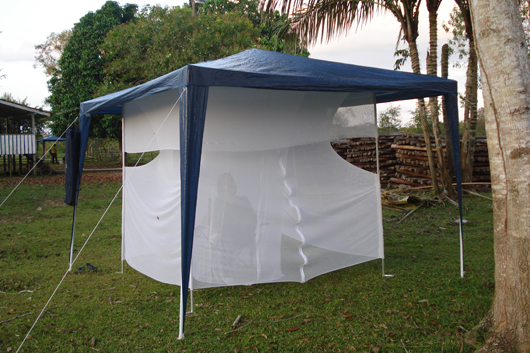Researchers innovate in malaria vector surveillance
02/05/2017
Lucas Rocha (IOC)
Researchers of Oswaldo Cruz Institute (IOC/Fiocruz), in partnership with the Institute of Scientific and Technological Research of the State of Amapá (Iepa), developed an innovative trap for the collection of mosquitoes, especially anophelines, that transmit malaria. The innovation represents three direct benefits: facilitates field researches, increases mosquito capture, and increases safety in relation to vector contact.
With a format similar to a tent, the tools has two cameras: the internal one designed to house the professional responsible for the collection, and the external one, where the collected mosquitoes are trapped. The separation between the two environments prevents the endemic agent or the researcher from being bitten by the captured mosquitoes that may be infected. Researchers proved the trap efficacy, the so-called MosqTent - union of the word ‘mosquito’ and ‘tent’ - in field tests conducted in Northern Brazil. Fiocruz submitted the patent to the National Institute of Industrial Property (Inpi), thus ensuring the right to intellectual property of the invention.
Currently, in accordance with the National Program for Malaria Prevention and Control of the Ministry of Health, the recommended capture technique for the monitoring of entomological indicators in relation to anopheles is through human attraction. With this method, the expert positions him/herself in mosquitoes’ habitat and they are attracted by the many odors naturally exhaled by the body using the necessary Personal Protective Equipment. When lading on the man, to try and feed themselves with blood, they are captured. According to the agency, other collection techniques do not show compatible efficiency.
“In this scenario, MosqTent presents itself as a new promising technology in the field of entomological surveillance of malaria, since it can be used replacing the direct human exposure. In addition, in areas with high density of anopheline mosquitoes, the tool has high capture capacity,” explains José Bento Pereira Lima, head of the Laboratory of Physiology and Control of Vector Arthropods of the IOC and one of the creators of the trap, along with Maria Goreti Rosa-Freitas, from the Laboratory of Mosquitoes Hematozoan Transmitters of the IOC, and Allan Kardec Ribeiro Galardo, from Iepa.
Professionals face adversities when collecting mosquitoes in the nature, especially the possibility to be infected by pathogens and such adversities are the starting point for the tool development. “Our idea was to join ease of capture and individual protection in one technology,” summarizes Goreti. Portable and with a light structure, the trap can be kept and transported in a bag. This technology is useful for studies in wild, domiciliary and peridomiciliary environments and dispenses electrical energy or other components to attract insects, such as carbon dioxide, for example.
An essential part of the surveillance, the collection allows measuring the quantity of mosquitoes inhabiting a region and further analyzing the percentage of people infected. Thus, risk of transmitting pathogens to the population can be estimated. Anophelines, for example, are part of a large group of mosquitoes that have a preference for human blood (anthropophilic), are of great importance for public health and objects of several studies around the world.
Performance tests
To check the trap’s efficacy, researchers conducted field studies in Cariobal in the rural area of Macapá, in Amapá - place with the presence of malária vectors. The tests reproduced real capture conditions in the months of August and October of 2009, and January and April of 2010, considering variations in mosquitoes’ density over the year. More than 22 thousand anophelines of five species were collected in total. “The tests showed, in practice, the high attractiveness of MosqTent to anopheline species,” emphasized José Bento.

According to analyses, the trap had a performance superior to other technologies as human attraction, protected human attraction in high insects’ density condition, which considers the use of long pants, long-sleeve shirt and black socks, and the ‘BG Sentinel’, a trap that uses carbon dioxide for attraction. In absolute numbers, MosqTent was able to collect approximately 30% more specimens of Anopheles marajoara, An. braziliensis and An. nuneztovari.
In addition to the testing period, MosqTent was used as an experiment by researchers from other IOC Laboratories in field studies with Simuliidae, popularly called black fly, and presented a positive performance in the capture of these insects that transmit onchocerciasis in Brazil.
Registration of an innovation
To obtain the patent registry, the trap was assessed by the Technology Innovation Nucleus (NIT) of the IOC and the Fiocruz Technology Management Coordination - institutional agencies that develop health innovation. Then, the patent was filed in the National Institute of Industrial Property (INPI). “The filing is an important step during a tool’s development; this should contribute for improvements in field researches worldwide,” emphasized José Bento. According to him, the main purpose of the patent process is to ensure the intellectual property of an innovation produced in Fiocruz’ laboratories and the future use of the trap for scientific and service purposes. Details on the trap operation and efficiency test results were gathered in an article published in the scientific newspaper PLOS Neglected Tropical Diseases.
Cases of malaria
The Amazon region, which covers the states of Acre, Amapá, Amazonas, Maranhão, Mato Grosso, Pará, Rondônia, Roraima and Tocantins, concentrates more than 99% of malaria cases registered in Brazil. However, despite only having a few notifications, the other regions cannot neglect the disease, since higher lethality rates are observed than the endemic region. Data from the Ministry of Health show that more than 143 thousand cases of the disease were notified in the country in 2015. Until September of 2016, more than 81 thousand cases of malaria were confirmed in Brazil.




